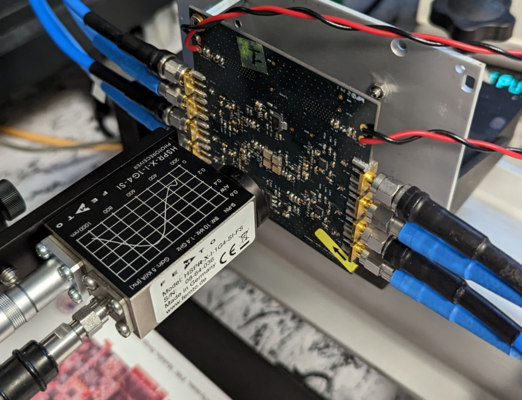Diamond-on-chip magnetic field camera for mobile imaging
In this work, we introduce concepts for spatially resolved magnetic field sensing and two-dimensional gradiometry with an integrated magnetic field camera. The camera utilizes infrared absorption optically detected magnetic resonance (IRA ODMR)...
LiFi for Industry 4.0: Main Features, Implementation and Initial Testing of IEEE Std 802.15.13
The recently approved IEEE standard 802.15.13 defines a deterministic medium access scheme with dynamically allocated time slices and two ways of coding and modulation for industrial light communication. We present our work on prototyping the...
Multi-Gbit/s LiFi Experiments with a VCSEL TX and an Enhanced Pulsed Modulation PHY
Enhancing an OOK-based PHY for LiFi, we show that the large bandwidth, high power, and low energy consumption of low-cost VCSEL arrays combined with SFP drivers can be utilized to reach Multi-Gbit/s data rates and enable user mobility in large...
On the Optimal Performance of Distributed Cell-Free Massive MIMO with LoS Propagation
We investigate the capability of team MMSE technique in enhancing distributed beamforming for dense user-centric cell free massive MIMO networks. Considering the anticipated ultra-dense nature of cell-free massive MIMO networks and the...
Doppler Power Spectrum in Channels with von Mises-Fisher Distribution of Scatterers
This paper presents a closed-form expression for Doppler spectrum in mobile wireless channels with von Mises-Fisher (vMF) angular distribution of scatters. The obtained result is employed to analyze the impact of the vMF scattering parameters...
Semantic Security with Infinite-Dimensional Quantum Eavesdropping Channel
We investigate the semantic security of classical and quantum communication channels in the presence of infinite-dimensional side channels. A new method for security proofs is developed, which allows to derive finite block-length results in the...
Joint Waveform Design for Communication and Sensing with Adjustable PAPR
This paper proposes a dual-functional waveform design for integrated sensing and communication systems under adjustable peak-to-average-power-ratio constraints.
Towards Infrastructure-assisted WiFi Rate Adaptation for Converged Networks with Morpheus
The paper discusses a novel framework to integrate heterogeneous Radio Access Technologies (RATs) with the 5G O-RAN for coordination and joint optimization. As an example, it lays out the architecture of a WiFi Radio Intelligent Controller (RIC)...
Lossless Decoupling Networks for RF Self-Interference Cancellation in MIMO Full-Duplex Transceivers
The article presents a novel self-interference cancellation (SIC) technique using a lossless decoupling network in the RF domain for dedicated transmit-receive antennas. It includes antenna coupling analysis, SISO and 2×2 MIMO tests, and a...
Mobilizing the Terahertz Beam: D-Band Analog-Beamforming Front-End Prototyping and Long-Range 6G Trials
This article presents a novel D-band (150-175 GHz) wireless transceiver, achieving 48 dBm EIRP with eight RF beams via a Rotman lens, outperforming prior versions. Developed with InGaAs MMIC technology, it enabled 6G trials, including a 9-meter...








